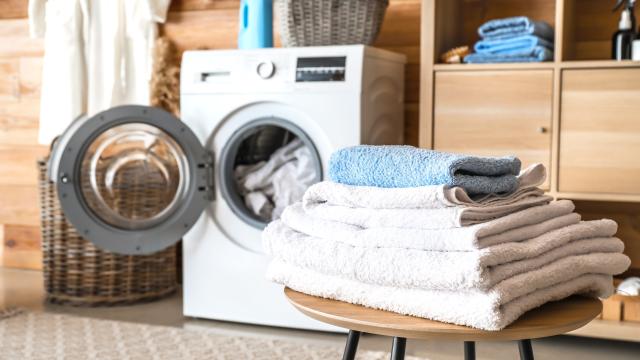New, freshly washed towels are great… until you use one and find yourself covered in lint. Even after you wash them again (and again), this problem can persist. Blame this frustrating process on the waxy, water-repellent layer of fabric softener that coats most new towels. While it’s intended to keep them looking extra plush and inviting on the shelf, this coating also acts like flypaper for loose fibres and dust — and it really doesn’t want to wash out.
If you want to break the never-ending cycle of fluff, you have to dissolve that “new towel” coating first. This is pretty easy to do with the right strategy and a little help from common household chemicals. The only downside is that it works best with 3 machine cycles: Two in the dryer and one in the washer. If you can’t or won’t pay for an extra cycle in a coin-operated or laundromat dryer, that’s OK — just skip the first one. I’ve done it both ways in my building’s ancient coin-op machines, and while the extra dryer cycle does make a difference, you can still get pretty good results without it.
[referenced id=”876535″ url=”https://www.lifehacker.com.au/2019/03/remove-pet-hair-from-fabrics-using-your-dryer/” thumb=”https://www.gizmodo.com.au/wp-content/uploads/sites/4/2019/03/06/u3aihommlqy0zim0wyzt.jpg” title=”Remove Pet Hair From Fabrics Using Your Dryer ” excerpt=”Cleaning pet hair off any surface is always a chore, but fabrics are very much the worst. Tempting as it may be, giving up and tossing a hair-coated blanket in with the rest of the wash will only transfer that hair to the rest of the load — and send…”]
Start by knocking off all the loose lint you can. To do this, shake the towels out vigorously, then run them through the dryer on a no-heat setting like air fluff. (For obvious reasons, make sure the lint trap is completely clean.) If your dryer doesn’t have a heatless cycle, use the lowest one you can — high heat “sets” the coating in place, making it even tougher to dissolve. Skip the dryer sheets; they’ll only add more of the coating you’re trying to remove. Before you put them in the washer, shake the towels out again to see how much lint comes off. If it’s a lot, clean out the trap and repeat the process.
Next, wash the towels alone in hot water with a detergent-boosting ingredient like vinegar, Borax, or baking soda. These chemicals will help the hot water and detergent break down the sticky coating and dislodge whatever’s stuck to it. For best results, use 1/2 to 1 cup of the booster and no more than half the recommended amount of detergent. To avoid piling on even more residue, don’t add extra detergent and definitely don’t use fabric softener.
[referenced id=”575712″ url=”https://www.lifehacker.com.au/2014/02/four-household-products-you-probably-use-too-much-of/” thumb=”https://www.gizmodo.com.au/wp-content/uploads/sites/4/2014/02/27/19gxcebmwp692jpg-300×169.jpg” title=”Four Household Products You Probably Use Too Much Of” excerpt=”If you’re like most people, you spend a fair amount on laundry detergent, dishwashing liquid and other cleaning products. Saving money on them doesn’t have to be just about finding a sale or switching to cheaper brands — the chances are you’re simply using too much. Let’s take a look…”]
The final step is to dry the towels on high heat without dryer sheets, which will undo all the hard work you just did. With any luck, you’ll now be ready to enjoy all the good parts of fresh towels and none of the lint.

Leave a Reply
You must be logged in to post a comment.